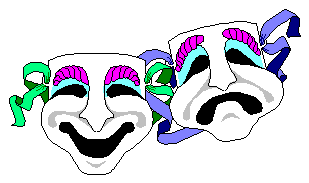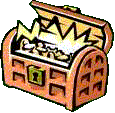Sherlock
Holmes and
the Secret Weapon
|
 The Swiss inventor and the old bookseller trick the Nazis and make their escape. |
 Sherlock Holmes removes the "old bookseller" makeup. |
Tobel divides his bomb site into four parts, each of which is meaningless without the others, and gives them to four scientists with instructions to reproduce his own part in quantity. No one but Tobel knows who has the four parts; these are the names written in the "dancing men" code. Then Tobel mysteriously disappears.
When Holmes learns that Tobel is missing, he visits Charlotte Eberli, and she gives him Tobel's envelope. It contains the message "We meet again, Mr. Holmes!" Charlotte is puzzled and tells him about the dancing men. She says no one has been in the apartment except an electrician who had "eyes like a snake." Holmes knows that the "electrician" was in reality Moriarty.
In the guise of a murderous lascar who was once in
Moriarty's employ, Sherlock Holmes tracks down Moriarty in Angel's Court.
| Moriarty: | My men have instructions to bring anyone here who inquires for me. They haggle while I watch. An admirable disguise by the way; it fooled them completely. Of course it didn't fool me. |
| Holmes: |
I never intended that it should. I meant only that it should bring us face to face. |
| Moriarty: | Just like old times, eh?. a battle of wits, of superior intellects. I may say I have been expecting you since I made off with your precious Dr. Tobel. |
| Holmes: | And his code. |
| Moriarty: | Ah, yes, and his code. But valuable as your doctor and his code are to my business, I think my main interest in this affair is the chance it gives me to battle with you again. |
To eliminate Holmes, Moriarty forces him to get into the false bottom of a sea chest, which then will be dumped overboard from a ship as soon as it's out of sight of land. Lestrade and Watson, who are outside keeping watch notice two men are staggering under the weight of the sea chest, and stop them, rescuing Holmes.
 Holmes questions Tobel after the scientist was attacked. |
 Holmes and Watson learn that Tobel has disappeared. |
Having learned that Moriarty plans to sell the bombsight to the Nazis, Holmes returns to Charlotte Eberli's apartment to find some clue to the "dancing men" message, which would reveal the names of the four scientists who have parts of the bombsight. He takes the tablet upon which Dr. Tobel wrote his message, and is able to make the message appear on the second sheet by soaking the page in a chemical solution. Watson recognizes the symbols as an alphabet substitution code. Holmes explains that the code is more complicated than that. He's able to decipher the first three names and addresses, but the fourth one doesn't fit the code. Moriarty has also broken the code for the first three names, and murdered those scientists. Holmes manages to break the code for the fourth name before Moriarty. By the time Moriarty's gang gets to Frederick Hoffner's house, Holmes is there in disguise; they kidnap Holmes and bring him to Moriarty. Moriarty tells Holmes that, since he didn't get the crucial fourth part of the bombsight, he will sell Tobel to Germany instead. Moriarty gloats that he will kill Holmes and that no one will be able to find him, not even Scotland Yard. As they sit and discuss what method of execution Moriarty will use on Holmes, Holmes offers his own suggestions.
"Gas, poison, bullets. I assure you, Professor, were our positions reversed, I should have something more colorful, more imaginative to offer. . . . You didn't trap me here. I came here because I wanted to, to prevent your getting Hoffner. And all you can do in return is to commit ordinary murder, to relieve your sense of frustration."
Holmes suggests that he would place Moriarty on an operating table, and draw off his blood, drop by drop until Moriarty dies. So that's exactly what Moriarty decides to do to Holmes.
Meanwhile Watson and Lestrade are on the trail. The real Hoffner attached a leaky can of luminous paint to the undercarriage of Holmes' abductors' car, and it has left a trail of paint spots on the road. They follow the spots to Moriarty's lair, and rescue Holmes just in time.
Everyone in Moriarty's gang is captured, but Moriarty accidentally falls through a trap door while trying to escape, and is apparently killedagain. (Moriarty was apparently killed at the end of "The Adventures of Sherlock Holmes;" he resurfaces in "The Woman in Green" and plunges to his apparent death at the end of that film as well.)
At the end of the film, as Holmes and Watson watch the take-offs of planes equipped with the new bombsights, Watson remarks, "Well, this little island is still on the map." In his closing patriotic speech characteristic of these wartime Sherlock Holmes films, Holmes responds with a quote from Shakespeare: "This fortress built by Nature for herself . . . This blessed plot, this earth, this realm, this England" (Richard II, Act II, Scene 1).
The "Dancing Men" code in the Conan Doyle story "The Adventure of the Dancing Men" was a simple alphabet-substitution code in which each letter of the alphabet was represented by a different stick figure. Holmes needed several messages in code in order to decipher it, and some of the letters were guessed at. (Holmes would say they were logical deductions.) He explained it to Watson and Inspector Martin, who were amazed. In the film, Dr. Tobel wrote important information in "Dancing Men" code on a single sheet of paper and made it more complicated than the simple alphabet-substitution code, believing that only Holmes would be able to solve it. (Moriarty was able to solve it, too.) Holmes hardly had to think about the code. He just looked at the figures and started calling out letters. Even the simple alphabet-substitution code isn't that simple, and cannot be broken with only one sample. The Conan Doyle story was more realistic and believable.
In spite of the incredible code-solving, the film is suspenseful and very entertaining. Rathbone enjoyed the opportunity to wear these disguises: a Swiss bookseller, a suspicious-looking foreign sailor, and a bearded scientist. The scenes between Rathbone and Atwill are especially engaging.
 Holmes discusses Dr. Tobel's disappearance with Tobel's girlfriend. |
 Holmes applies makeup for one of his disguises. |
The scenes taking place in Switzerland were filmed on Universal's back lot. The film released in Los Angeles, California on December 25, 1942. The general release date in the USA was February 12, 1943. The film was re-released December 1, 1948. The original copyright on Sherlock Holmes and the Secret Weapon was not renewed, and as a result, the film fell into the public domain.
In The Films of Sherlock Holmes, Chris Steinbrunner and Norman Michaels state: "A baffling bit of casting in Sherlock Holmes and the Secret Weapon was the use of splendidly saturnine Henry Daniell, . . . here in the brief role of a Scotland Yard man in the final car pursuit of the Professor" (The Films of Sherlock Holmes, by Chris Steinbrunner and Norman Michaels, Citadel Press, 1978, p. 99). I watched the final car pursuit scene carefully and didn't see Henry Daniell. Although it's difficult to see all the bit players' faces clearly, I do not believe Daniell was one of them. The Internet Movie Database claims to have a complete list of cast and crew for this film, and Daniell is not listed as part of the cast.
Roy William Neill had been directing films since 1917. He signed contract with Universal in early 1942 and came on board to direct Sherlock Holmes and the Secret Weapon. Except for Sherlock Holmes in Washington, Neill both produced and directed the remaining Sherlock Holmes films of the series. Sadly, Neill died near the end of 1946. He was just 59 years old.
"Neill had the amazing ability to create atmospheric moments with lights, a few set pieces, and an occasional fog machine and his scenes were always captivatingly composed and staged." Michael Hoey, Sherlock Holmes & the Fabulous Faces (BearManor Media, 2011) p. 35
In his unpublished memoirs Games, Gossip and Greasepaint, Nigel Bruce wrote the following about Roy William Neill: "He was a little man, very fussy about his clothes and like myself, he always smoked a pipe. He was an extremely kind and friendly person and all his assistants and the crews who worked for him were devoted to him. Roy was an extremely able director, having a great knowledge of film technique and of the use of his camera. During the many pictures we made under his direction we found him a joy to work for. Basil and I nicknamed him 'mousey' during our first picture and the name stuck to him from then on. We both became extremely attached to Roy Neill."
 Holmes has found Moriarty. |
 Watson and Lestrade rescue Holmes from the sea chest. |
Lionel Atwill is positively fiendish as Moriarty. With his eyes heavily lidded to give a reptilian look, Atwill certainly matches Conan Doyle's description of Moriarty. Rathbone and Atwill appeared together in four previous films: Captain Blood (1935), Son of Frankenstein (1939), The Sun Never Sets (1939), and The Hound of the Baskervilles (1939). Atwill played Dr. Mortimer in The Hound of the Baskervilles. Rathbone also worked with Atwill in the 1930 play A Kiss of Importance, which was directed by Atwill.
Sherlock Holmes and the Secret Weapon introduces Dennis Hoey as Inspector Lestrade. Like Watson, Lestrade always came through in a pinch. Curiously, the character of Lestrade didn't appear in "The Dancing Men." At six foot three inches, Hoey doesn't resemble the description of Lestrade in Arthur Conan Doyle's stories. Lestrade is described as "a little sallow, rat-faced, dark-eyed fellow" in the stories. Also in contrast to the Lestrade of the stories, Hoey spoke with a Cockney accent.
Kaaren Verne was a German actress who fled Germany in 1938. One of her three husbands was actor Peter Lorre, who later appeared with Basil Rathbone in The Comedy of Terrors and Tales of Terror.
William Post was an American actor whose role of the inventor in Secret Weapon required him to use a broad European accent. Having a quick ear for inflections, Post chose the type of accent used in real life by a refugee scientist whom he met in New York.
Holmes Herbert (Sir Reginald) also appeared in The Adventures of Sherlock Holmes, Sherlock Holmes in Washington, The Pearl of Death, and Dressed to Kill.
Harry Cording (Jack Brady) appeared in eight of the Sherlock Holmes films: The Adventures of Sherlock Holmes, Sherlock Holmes and the Voice of Terror, Sherlock Holmes and the Secret Weapon, The Spider Woman, The Pearl of Death, The House of Fear, Terror by Night, and Dressed to Kill.
 Holmes describes the method of recovering the Dancing Men code. |
 Holmes works on the code. |
The press book for Sherlock Holmes and the Secret Weapon reported that Basil Rathbone refused to be seen in the Universal studio cafe during the making of this motion picture. The star declared he could not face the stares of the other diners. For his role as Holmes in this film, Rathbone donned a disguise which he claimed put him into the same class with Frankenstein and the Wolf Man. Rathbone brought his own lunch to the studio and spent his noon hours in the sound recording laboratories.
Nigel Bruce flatly refused to wear a flannel nightgown as called for by the script of Sherlock Holmes and the Secret Weapon in which he appears as Dr. Watson. A description of the outfit called for in the script read as follows: "Bruce appears wearing a flannelette nightgown open at the sides, hitched up in the front and hanging down at the back. He is wearing a white knitted night cap with a tassel and has on enormous sheepskin house slippers."
Director Roy William Neill finally gave in when he saw how serious Bruce was in his objection, and permitted the actor to wear a regulation suit of tailored pajamas and a dressing robe.
The press book for Sherlock Holmes and the Secret Weapon has a brief article about how the rubber shortage affected Jack Pierce, the Universal studio make-up man. Much of the equipment used by the armed forces in World War II required rubber. And the Japanese had taken over the rubber plantations in Southeast Asia, resulting in a rubber shortage in the USA. The article explains how Pierce handled the problem:
| In the past, most of the fantastic make-up creations of Pierce, in
which he changed the facial characteristics of actors, utilized a solution
of plastic rubber. Because it deteriorated rapidly, the make-up department
never carried a large supply on hand. To overcome the shortage in plastic rubber, Pierce, a highly skilled amateur chemist, devised a process of using reclaimed rubber sponges, the base being mixed with a solution of alcohol and liquid glass. The process was used with success for the first time in a make-up on Basil Rathbone, who as Sherlock Holmes, dons a disguise of an aged bookseller. Rathbone also appears as a dockworker in the detective story thriller. |
.
 They find one of the scientists has just been murdered. |
 Holmes deciphers the name of the fourth scientist. |
Another story from the press book: Denis Conan Doyle, son of the famous author of the Sherlock Holmes detective stories, was a guest of Nigel Bruce and Basil Rathbone at Universal studio during the making of Sherlock Holmes and the Secret Weapon. As the son of the author stood intently on the sidelines watching the actors run through a scene, he was approached timidly by a white-haired, erect man who spoke in a clipped Scotch accent.
"I'm Captain George Hill," the man said. "I knew your father 40 years ago in Edinburgh."
Captain Hill disclosed that at the time he met Sir Arthur Conan Doyle, he was Chief of Police of Edinburgh, with a thousand men under him. Doyle, said Captain Hill, frequently visited police headquarters and discussed crime detection.
Captain Hill was a stand-in for Nigel Bruce.
"The detective tangles with his old enemy, Moriarty." Motion Picture Reviews
"The film was a vast improvement over the series' initial entryin all areas of production." Michael Druxman, Basil Rathbone: His Life and His Films, by Michael B. Druxman (Hardcover: South Brunswick and New York: A.S. Barnes, 1975) Paperback edition: BearManor Media, 2011.
"Direction by Roy William Neill ... holds attention upon the detective virtually all the way." Motion Picture Daily
 Moriarty and Holmes discuss ways to kill one another. |
 Holmes has the upper hand. |
"The deciphering of an involved cryptic code, revealing the whereabouts of the secret weapon, is an interesting highlight." Photoplay combined with Movie Mirror, April 1943
"The aura is still mysterious, the action is fast and tense." The New York Times, January 5, 1943
"Basil Rathbone assumes the part of Sherlock Holmes with the suavity that is his stock in trade." Hollywood Reporter
Watch the colorized trailer for Sherlock Holmes and the Secret Weapon:
Go to Page Two for more screenshots from The Secret Weapon. See Page Three for pictures of posters, lobby cards and promo photos.
.
|
Images on this page and pages two and three are from the film Sherlock Holmes and the Secret Weapon.
.
Sherlock Holmes and the
Secret Weapon is available
on DVD: Click to order |
DVD also available as part
of The Sherlock Holmes Collection, Volume 1: Click to order |
Note: Sherlock Holmes and the Secret Weapon is one of the four Sherlock Holmes films that is in the public domain. That means that anyone can legally produce and sell a DVD of this film. Consequently, it's easy to find cheap DVDs of Sherlock Holmes and the Secret Weapon. But these cheap ones are also cheap quality. The links above are for the digitally remastered, high-quality DVDs produced by MPI Home Video. Don't waste your money on anything else!












